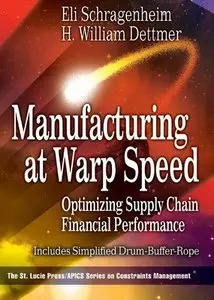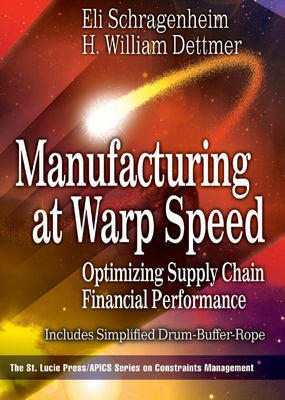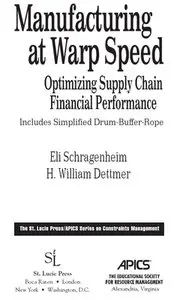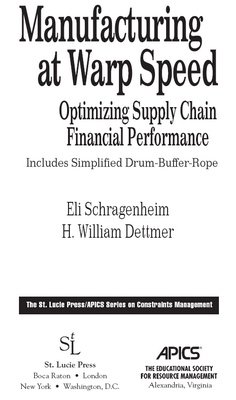"Manufacturing at Warp Speed: Optimizing Supply Chain Financial Performance" by Eli Schragenheim, H William Dettmer
The CRC Press Series on Constraints Management
СRС Press | 2000 | ISBN: 1574442937 9781574442939 | 377 pages | PDF | 18 MB
The CRC Press Series on Constraints Management
СRС Press | 2000 | ISBN: 1574442937 9781574442939 | 377 pages | PDF | 18 MB
Manufacturing systems don't exist in a vacuum, isolated from the rest of the company, but they are often managed that way. The authors have shown how the the Theory of Constraints can improve your business quickly and effectively. They clearly explain how it operates within existing legacy systems or can be used as the basis for a much improved brand new solution.
Contents
Preface
Introduction
Case Study: Reliable Manufacturing, Inc.
What Are Our Requirements for a Solution?
Four Parts
Learning Outcomes
PART I Managing System Constraints
1 Systems Thinking: The Foundation
System vs. Process
Work Flow vs. the Organization Chart
Suboptimization
Local vs. System Optima
Systems as Chains
The Manufacturing Chain
The Expanded Manufacturing Chain
The Eternal Constraint
The Importance of Knowing What the System Constraint Is
2 Principles and Tools of the Theory of Constraints
Constraint Management Assumption #1
Constraint Management Assumption #2
Constraint Management Assumption #3
The Airplane Analogy
The “Nero Effect”
Implications of Assumption #3
The Theory of Constraints Approach to System Management
The Five Focusing Steps
The TOC Perspective: A Summary
Ramifications of the Five Focusing Steps
3 Assessing System Success
Evaluating Operating Decisions: The Traditional Approach
Evaluating Operating Decisions: The TOC Approach
Relation of T, I, and OE to Traditional Business Measures of Merit
What Should Our Priorities Be?
T, I, and OE: An Example
Throughput (Constraint) Accounting
4 Constraint Management Tools
Types of Constraints
Constraint Types: Examples
The Logical Thinking Process
Critical Chain
Drum-Buffer-Rope Production Scheduling
The Five Focusing Steps Revisited
5 How Work Flows through a Manufacturing Process
Various Manufacturing Environments and Their Specific Problems
PART II Traditional Drum-Buffer-Rope
6 Applying Constraints Theory to Manufacturing Operations
The Simple Production Organization
Injections: Breaking Conflict #1
Transfer Batches
Injections: Breaking Conflict #2
Injections: Breaking Conflict #3
Future Reality Tree: Plant 120
Generic Manufacturing Conflict
7 Traditional Drum-Buffer-Rope
What DBR Does
What DBR Does Not Do
Some Basic DBR Principles
Guidelines for DBR Shop Floor Planning
DBR Basic Concepts
The Control Conflict: Detail or No Detail?
Buffers: Traditional DBR
Preliminary Actions
The Control Conflict Revisited
Managing Non-Constraints in a DBR Environment
8 Traditional Buffer Management: The DBR Control Mechanism
The Buffer Concept
Buffer Management
DBR Buffers: Three Zones
Holes in a Buffer
How a Hole in a Buffer Appears in the Master Production Schedule
DBR Buffer Zones: A CCR Example
Three Benefits of Buffer Management
How to Realize the Benefits of Buffer Management
Identifying an Emerging Constraint: An Example
9 Drum-Buffer-Rope (DBR) and Manufacturing Resource Planning (MRP)
MRP Advantages
MRP Disadvantages
MRP Policies That Can Create Problems
Overcoming MRP’s Disadvantages
MRP Lead Times and Queues
Establishing the Rope
Problems in DBR Implementation within MRP Systems
DBR-Specific Software and Dynamic Buffers
PART III Simplified Drum-Buffer-Rope
10 Simplified Drum-Buffer Rope (S-DBR)
Difficulties in Applying Traditional DBR
S-DBR: Simplified, Effective
S-DBR: Basic Assumptions
S-DBR: Operating Principles
S-DBR: A Graphic Depiction
Implementing Simplified DBR
S-DBR Control
S-DBR Problem Situations
Traditional DBR and S-DBR: Which to Use When?
11 Controlling Uncertainty and Variation: The S-DBR Approach
Buffers: A Quick Review
Definition of Control
Objectives of Red-Line Control (Buffer Management)
How Red-Line Control Works
Red-Line Control for Raw Materials
Red-Line Control: Limitations
Planned Load: An Important Control Information Source
Rough-Cut Capacity as a Control Mechanism
Control in S-DBR: A Summary
Plant ADV200: An S-DBR Simulation
12 Managing Excess Capacity
Excess Capacity: What Can We Do with It?
Excess Capacity: Protection from What?
The Dilemma of Maintaining Excess Capacity
The Excess Capacity Conflict
Effects of Various Policies on Actual Production Lead Time
Excess Capacity: A New Way to Think about It
Common Reasons Why Excess Capacity Remains Hidden
The Cost Mentality and Excess Capacity
When is “Excess” Too Much?
How to Prepare for Excess Capacity
How to Expose Excess Capacity
Summary
PART IV Optimizing Decisions
13 Throughput-Based Decision Support
Management’s Problem
Management’s Challenge
Traditional Global Measurements
TOC Global Measurements
Link between TOC and Traditional Global Financial Measurements
How T, I, and OE Support Daily Decisions
Calculating the Financial Impact
The Logic of Measurements
How T, I, and OE Support Daily Decisions: Another Example
Using T, I, and OE in Making Daily Decisions
How to Load the CCR and Maximize T without Increasing OE and I
Throughput-per-Constraint-Unit Rule: An Example
When No CCR Exists: Decision Rules
How Do Big Decisions Differ from Small Ones?
The TOC Decision Rule
14 Drum-Buffer-Rope (DBR) and Enterprise Resource Planning (ERP)
Think “E,” Manage “E”: Management in the ERP Era
Case Study: SMPRO, Inc.
Problems Related to Information at SMPRO
ERP Implementation: Basic Assumptions
The Second ERP Assumption
The Third ERP Assumption
Why ERP?
TOC Support in an ERP System
Supply Chain Management
Conclusion: Lessons Learned
Appendices
Appendix A:The Dice Game
Appendix B: The Management Interactive Case Study Simulator (MICSS)
Appendix C:Plant 120
Appendix D:The ADV200 Company
Bibliography
Index
with TOC BookMarkLinks





